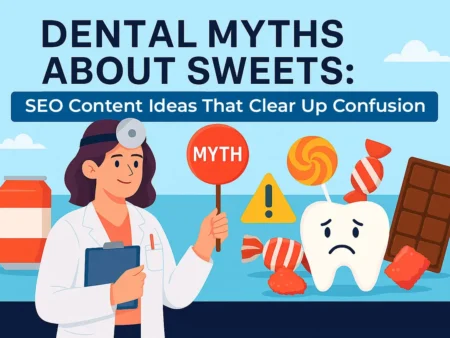
Many people associate sweets with instant tooth decay and assume that any amount of sugar leads directly to cavities. While it is true that sugar can affect oral health, not everything commonly believed about sweets and teeth is accurate. For dental professionals and marketing specialists alike, addressing misconceptions about sugar can help attract new patients seeking reliable information online. A professional dental marketing strategy that incorporates myth-busting content can make a practice stand out in Clearwater and beyond.
Myth One: All Sugar Damages Teeth in the Same Way
Not all sugars taste the same in the mouth. Caramels and gummies are examples of sticky candies that stick to teeth. This allows bacteria more time to eat sugar and make acid. Chocolate, on the other hand, washes off more easily and doesn’t stay on the skin as long. Natural sugars in fruits are healthier, but they can cause decay if you don’t brush.
Blog posts that compare different types of sugar and their effects can be a beneficial way to do SEO for dental websites. Giving this much information can encourage visitors to read more, thereby improving on-page engagement metrics.
Myth Two: Sugar-Free Means Cavity-Free
Many people think that sugar-free sweets can’t harm their teeth, even though they are becoming more popular. Some sugar substitutes, especially acidic flavor enhancers, can wear down enamel even when they contain no sugar.
Dentists can teach their patients that sugar-free gums with xylitol may help prevent tooth decay, but drinks labeled “diet” or “low-calorie” can still harm enamel. From an SEO perspective, this topic lets a practice show up in search results for questions like “Do sugar-free candies cause cavities?” or “Best gum for dental health.”
Myth Three: Brushing Right After Eating Candy Prevents Damage
Brushing is essential for keeping your mouth clean, but doing it right after eating sweets can sometimes hurt your enamel. Acidic foods and drinks can temporarily soften enamel, and brushing too soon could remove its protective layer.
A lot of the time, dentists recommend waiting about 30 minutes after eating sweets or drinking soda before brushing. Creating content about when to brush your teeth can answer common patient questions and make a dental website appear like a reliable source of information.
Myth Four: Only Children Get Cavities from Sweets
Cavities can happen to anyone, no matter how old they are. Adults who snack frequently or drink sugary coffee can also get cavities. Gum recession, which exposes the roots, makes the risk even higher.
Dental offices can write SEO articles on how to prevent cavities in adults, using phrases like “How sugar affects adult teeth” or “Why adults develop cavities.” These kinds of educational posts appeal to a wider audience, making them more visible online.
Myth Five: Hard Candy Is Better Than Sticky Candy
Many people think hard candies are safer because they don’t stick to teeth. In reality, sucking on dense candy keeps sugar in contact with enamel for longer, and biting it can chip or crack teeth.
Discussing these minor details in blog posts provides readers with a comprehensive understanding. It also lays the groundwork for connecting to other preventive care services, such as fluoride treatments or sealants, to improve the internal SEO structure.
Myth Six: Soda Is the Only Sugary Threat
People talk a lot about the sugar and acid levels in soda, but many other drinks can do the same thing. Flavored waters, sweetened teas, and sports drinks can also lower your mouth’s pH and increase your risk of tooth decay.
Health-conscious readers often find dental websites that compare popular drinks and offer healthier options through organic search traffic. Adding questions like “Is sparkling water bad for teeth?” to article subheadings can help them rank even higher.
Myth Seven: Fruit Snacks Are a Healthy Substitute
Fruit snacks may seem healthy because they have fruit flavors or concentrates, but most contain a lot of sugar. They also stick to teeth like candy does. Patients often don’t understand the difference between whole fruits and processed fruit snacks.
Dental websites can rank for informational queries about family dental health while also promoting healthy eating habits by writing content that clearly highlights this distinction.
Creating Educational SEO Content That Builds Trust
From an SEO perspective, these topics are excellent for getting your site to rank for popular search terms, building authority, and keeping readers on your site longer. When you provide people with accurate information and explain things in a way that makes sense to them, they are more likely to share it on social media and help your business grow naturally.
A Clearwater dental office that wants to reach more people can add blog posts like these to its regular content calendar. Publishing educational articles regularly improves your website’s performance and makes you more trustworthy with patients who value open communication.
For experienced assistance in creating SEO-optimized dental content that attracts readers and clarifies common misconceptions, contact Affordable Dental SEO. Their team specializes in crafting strategies that help Clearwater dental professionals connect with patients through explicit, informative, and trustworthy online content.
Picture Source: AI-generated

